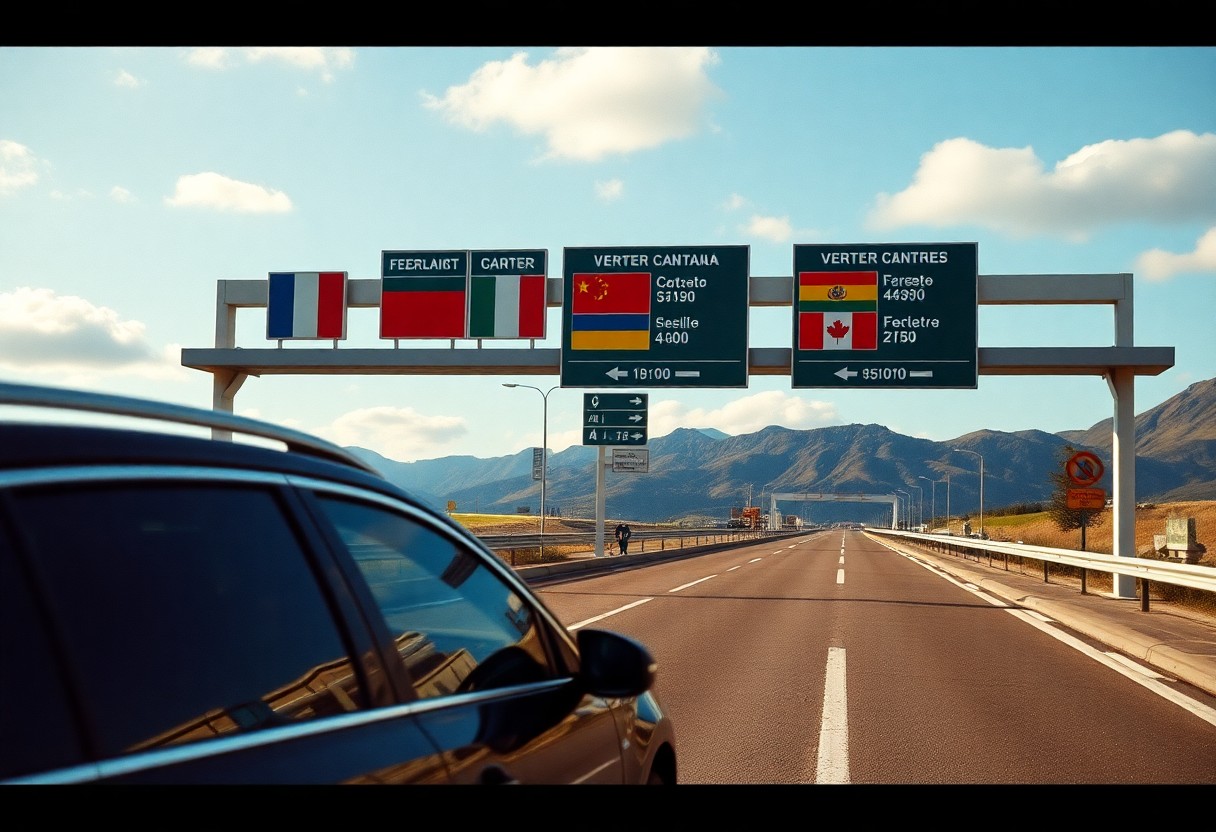Overseas travel in Europe with a rental car requires careful planning of your route and understanding of cross-border rules. You will find that rental companies have different policies about driving between European countries. Most companies allow travel within Western European nations but restrict movement to Eastern European countries. Your rental agreement will specify which borders you can cross and what additional fees you need to pay. Before you book, you should check if your preferred rental company permits travel to all countries on your itinerary. Breaking cross-border rules can void your insurance coverage and result in hefty penalties, so getting clear information about restrictions is vital for your European road trip.
Basic Requirements and Considerations
To drive a rental car across European borders, you need to meet specific legal and rental company requirements. Your rental agreement must explicitly allow cross-border travel, and you must have valid insurance coverage for all countries you plan to visit. Many rental companies restrict travel to specific European zones, with stricter rules applying to luxury vehicles.
International Driving Permit
One of the imperative documents you need is an International Driving Permit (IDP). You must obtain this permit from your home country before traveling to Europe. The IDP works alongside your regular driver’s license and is required by law in many European countries.
Mileage and General Restrictions
At most European rental locations, you’ll find vehicles with unlimited mileage options. However, border crossing fees apply, ranging from €5 to €47.60 per crossing, depending on the rental company and countries involved.
Due to insurance and security reasons, rental companies set specific restrictions for different vehicle categories. Luxury brands like BMW, Mercedes, and Audi often have more limited travel zones than standard vehicles. You’ll need to declare your travel plans in advance to ensure compliance with rental terms and avoid unexpected charges.

Major Rental Companies’ Policies
While renting a car in Europe, you need to understand that each company has different cross-border policies. Most major rental companies allow travel between Western European countries but have strict restrictions for Eastern Europe. You’ll find that policies vary based on the vehicle type, with luxury cars facing more limitations than standard models.
Avis and Enterprise Rules
Above all, Avis and Enterprise offer extensive coverage across Western Europe. You can drive their vehicles in most EU countries, including France, Germany, and Spain. However, both companies place special restrictions on luxury vehicles, particularly when entering Italy. Enterprise charges a daily cross-border fee of 5 euros, with a maximum of 50 euros.
AutoEurope and Hertz Regulations
Among the major providers, AutoEurope and Hertz maintain specific country restrictions. You cannot take their vehicles into Eastern European countries like Albania, Belarus, or Ukraine. Hertz prohibits luxury vehicles and SUVs from entering Italy, while AutoEurope’s policies depend on their local partners.
Hence, before you book your rental car, you must declare your travel plans to your chosen provider. Your rental agreement will include cross-border fees, which vary by company and destination. For example, Hertz charges 47.60 euros for crossing from Germany to another permitted country, and you’ll need additional insurance coverage for international travel.
Geographical Restrictions
The rules for cross-border travel with rental cars in Europe vary by company and vehicle type. Your rental agreement will specify which countries you can visit with your rental car. You must inform your rental company about your planned route, as crossing borders without permission can void your insurance.
Permitted Countries
At most rental companies, you can drive freely within Western European countries like France, Germany, and Spain. Zone 1 countries typically include EU member states in Western Europe, where you’ll have the most flexibility with your rental car. Your rental agreement will list all permitted countries for your specific vehicle class.
Restricted Territories
Behind the Iron Curtain countries are often restricted. Most rental companies prohibit driving to Eastern European countries like Albania, Belarus, Ukraine, and Russia. You’ll face limitations when traveling to these regions.
Additional restrictions apply to luxury vehicles and specific car brands. BMW, Mercedes, and high-end vehicles often have stricter geographical limits. If you plan to visit multiple countries, you should choose a standard vehicle class for maximum flexibility and avoid potential fees or insurance issues.
Vehicle-Specific Limitations
Despite rental companies having different policies, most enforce strict rules about which vehicles can cross borders. You need to check the specific limitations for your chosen vehicle class before booking. These restrictions protect valuable assets and comply with insurance requirements across different European territories.
Standard Cars
Against common belief, standard rental cars offer the most flexibility for cross-border travel. You can drive these vehicles in most Western European countries without special permits. However, you must inform your rental company about your travel plans and may need to pay cross-border fees of 5-50 euros.
Luxury Vehicles
One important restriction applies to high-end vehicles: luxury cars face significant limitations on border crossings. Brands like BMW, Mercedes, and Audi often can’t enter Eastern European countries or Italy. These vehicles are typically limited to Zone 1 countries in Western Europe.
In addition, if you plan to rent luxury vehicles, you’ll face higher security deposits and stricter insurance requirements. Companies like Sixt and Enterprise specifically restrict vehicles from premium brands like Jaguar, Maserati, and Porsche to select Western European countries only. You’ll need special permission and additional insurance coverage for any border crossings.
Border Crossing Costs
Keep your budget in mind when planning cross-border trips in Europe with a rental car. Most rental companies charge additional fees for crossing borders, even within the Schengen Area. You need to inform your rental company about your planned route and get written permission before crossing any borders.
Standard Fees
Between €5 and €50 is the typical range for border crossing fees in Europe. For example, you’ll pay €47.60 with Hertz when crossing from Germany to another allowed country, while Enterprise charges €5 per day up to €50 for trips starting in Germany.
Additional Charges
At some borders, you may face extra insurance requirements and documentation fees. Your rental company might charge for special permits, especially when traveling to Eastern European countries or with luxury vehicles.
Further costs can include higher insurance premiums for certain destinations, like Italy or Eastern Europe. You should also consider that some credit card insurance policies don’t cover all European countries, which may require you to purchase additional coverage from your rental company.

Ferry Travel Rules
Not all rental companies have the same ferry travel policies in Europe. While most companies allow ferry travel, you need to check specific rules for your rental. Crossing water borders requires additional documentation and may incur extra fees. Your insurance coverage might also change when traveling by ferry.
Company Policies
Among major rental companies, policies vary significantly. Avis and Hertz permit ferry travel to approved countries, but you must verify destination restrictions beforehand. Enterprise and Sixt may require pre-authorization and additional insurance for ferry crossings. Your rental agreement must explicitly state ferry travel permission.
Breakdown Considerations
An important factor to consider is vehicle breakdown coverage on islands. Most rental companies hold you responsible for vehicle repatriation costs if your car breaks down after a ferry crossing. These costs can reach several thousand euros, depending on your location and the type of vehicle.
This responsibility extends beyond mechanical issues. If you have an accident or the car becomes unusable for any reason while on an island, you must pay for transportation back to the original rental location. Some companies offer additional insurance to cover these costs, but you need to purchase it before your journey.
Summing up
So, when you plan to drive your rental car across European borders, you need to check specific rules with your rental company. You can cross borders in most European countries, but each rental company has different policies and fees. Your rental type affects where you can go – luxury cars often face more limits than standard vehicles. You’ll need to confirm allowed countries, pay any border crossing fees, and check ferry rules before your trip. Always read the rental agreement carefully and get an International Driving Permit. Your advance planning will help avoid problems at border crossings.
FAQ
Can I drive my rental car to any European country?
No, rental companies have specific rules about which countries you can visit. Most companies allow travel within Western European countries like France, Germany, and Spain. However, many restrict travel to Eastern European countries like Albania, Belarus, and Ukraine. Luxury vehicles often have more restrictions. You must check your rental agreement for allowed countries before crossing borders.
Do I need to pay extra fees for crossing borders with a rental car in Europe?
Yes, many rental companies charge border crossing fees. For example, Hertz charges 47.60 euros per border crossing from Germany, while Enterprise charges 5 euros per day (up to 50 euros maximum) for trips starting in Germany. These fees apply even within the Schengen Area. You must inform the rental company about your travel plans and pay these fees before crossing borders.
Can I take my rental car on a ferry between European countries?
Yes, most rental companies allow ferry travel if the destination country is on their approved list. However, if your car breaks down on an island, you must pay the cost to return the vehicle to its original location. Some companies like Hertz offer coverage for ferry travel through their insurance options (CDW, TP, or SuperCover). Always check the specific ferry policies in your rental agreement.





Your insights on the complexities of cross-border rental car travel in Europe are quite pertinent, especially given how nuanced the rules can be. It’s fascinating how Europe, despite its relatively small size, has such varied regulations and practices regarding vehicle rentals. I recall a trip a few years ago where my friends and I planned to explore several countries in a single trip. We were excited and naively assumed that as long as we were in the EU, there wouldn’t be much to worry about. This was compounded by the fact that we often saw countless travelers doing the same and sharing their adventures online.
It’s interesting how often we assume that the rules will be more uniform across Europe, especially when travel seems so seamless from the outside. Your experience really highlights that disconnect. In the EU, while the free movement of goods and people might make traveling feel straightforward, rental car regulations can differ significantly from one country to another. For instance, it might surprise some travelers to learn about specific requirements like the need for an International Driving Permit in certain countries, or how insurance coverage can vary.
You’ve touched on a fascinating point that often gets overlooked, and it’s one that many travelers may not fully appreciate until they find themselves navigating the ins and outs of car rentals in Europe. We’re so accustomed to moving freely from one country to another that it can feel like a single, cohesive space. However, the reality is that each country operates under its own set of rules and regulations, especially when it comes to something as essential as driving.
It’s interesting to hear about your experience traveling through Europe with friends. Many people share the same assumption that being in the EU simplifies everything. Yet, the reality can be quite different. Each country not only has its own regulations but also nuances in terms of insurance coverage, toll fees, and even driving laws.
I appreciate how you’ve highlighted the importance of understanding the nuances of cross-border travel when renting a car in Europe. It’s so true that travelers can inadvertently overlook these complexities in the excitement of planning their trips.
It’s great to hear you resonate with that perspective. Navigating the ins and outs of cross-border travel really can be a bit of a maze, can’t it? I remember planning a road trip through several countries in Europe and nearly missed out on some important details, like driving laws that change from one country to the next, or the toll systems that can get pretty confusing.
I found a great resource that dives deeper into the intricacies of rental car insurance—it’s a must-read for anyone planning cross-border travel in Europe.
‘The Complete Guide to Rental Car Insurance: What You Need to Know’
https://rentacar24.org/rental-car-insurance-what-you-need-to-know/.
It’s interesting to think about how much planning goes into a European road trip, especially with the diverse regulations depending on the rental company and country. A few years back, I decided to explore a few countries in Europe by car, and I learned the hard way just how important it is to read the fine print. I had an itinerary that crossed through several countries, but when I booked the car, I overlooked the clauses about Eastern Europe, which led to some anxious moments at the border!
It’s definitely a lesson learned when navigating the complexities of European road trips. It can be easy to get caught up in the excitement of planning a diverse itinerary, but those fine print details can really make or break the journey. I’ve had my own share of similar experiences, especially when I traveled through Central and Eastern Europe. It’s fascinating how regulations vary not just by country but also by rental company, which adds another layer of planning.
Reading your post really struck a chord with me, as I’ve recently been navigating the maze of planning a road trip across Europe. The insights you shared about rental car policies and cross-border travel hit home because I can attest to the importance of understanding these nuances. Last summer, my friends and I rented a car to explore both Italy and Slovenia, and while we had a blast, we definitely learned the hard way about the varying rules among rental companies.